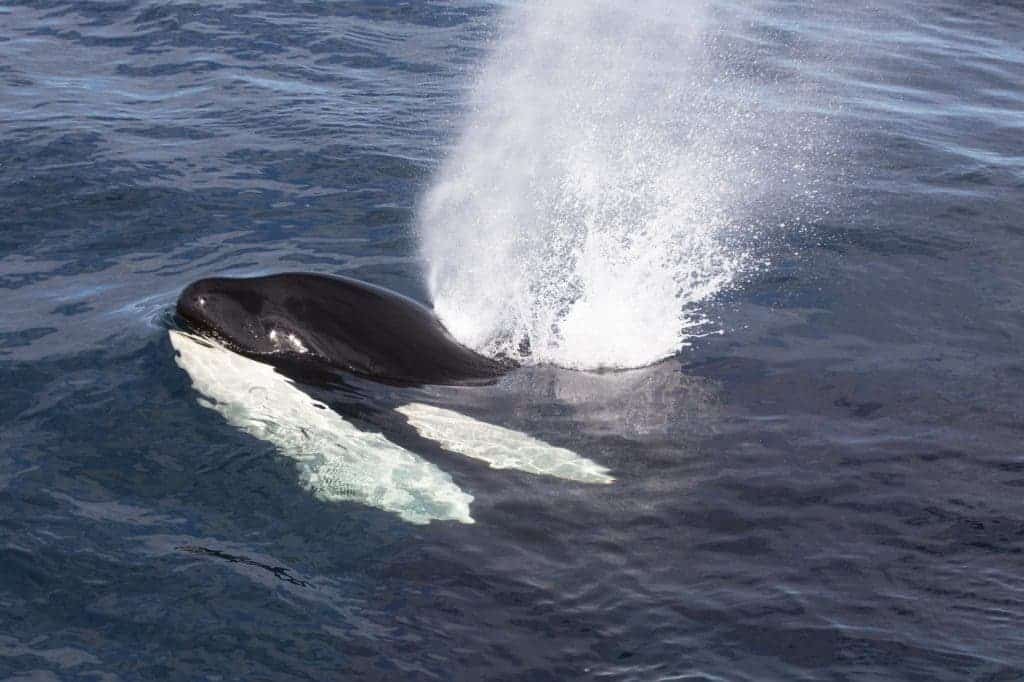Drones have become increasingly used for research on cetaceans. Remotely controlled from distances of up to several hundred meters, drones enable the capture of unbiased behaviors whilst removing potential disturbances that could arise from boats standing directly around the animals. Moreover, drones enable observations of activities that may occur within the first meters below the surface, yet completely out of the observers’ sight.
In Norway, a research project regularly uses drones to investigate dietary habits and predation behaviours of killer whale groups. So far, and based on studies from the last three decades, Norwegian killer whales have been thought to be relying on the Atlantic herring as a main prey. However, a subset of groups also appears to regularly prey upon pinnipeds, as first documented by Vongraven & Bisther (2014). Part of an ongoing study that aims at monitoring the extent of killer whale predation on pinnipeds in northern Norway, a research team recently launched a drone above a group of killer whales hunting and feeding on a harbour seal. The drone captured stunning footages showing a group of killer whales cooperatively hunting and subsequently sharing a pinniped-prey. The video is available below.
https://www.youtube.com/watch?v=qN45uAJ1Aqw
With consistent heading, speed and between-individual spacing, the five killer whales, presumed to be foraging, were travelling with approximately 5 knots along the shoreline. Suddenly, the large male of the group showed drastic behavioral changes, displaying sharp turns, explosive breathings and arching his back while diving. In a matter of only a few seconds, all the four other whales adopted similar displays. Thereby, the perfectly synchronous surfacing behaviour that first characterized the travelling whales rapidly turned into a pattern where the whales were alternately coming up to breath. Each whale surfacing seemed to systematically dive straight downwards, and the whole group remained on this restricted spot, where something was apparently going on.
Explanations came shortly when the drone flying above the spot revealed a seal laying on the surface, apparently exhausted. The five killer whales were persistently circling it, leaving it with no chance to escape towards the haul-outs nearby. After a minute, the seal attempted a fast escape down to the bottom, as visible on the footage. The immediate reaction of the five whales, prompted by a flying start, was to rush after it. For a few minutes, the sea surface remained quiet. The seal may have escaped to the bottom where cavities and rocks offer hiding places. Yet, killer whales are skilled top-predators able to cooperatively search and handle all prey types and, eventually, the group came up back to the surface with the prey: dead.
Seal-eating killer whales that frequent Norwegian coastal waters appear to have different strategies to killing their seal-prey, based on the situation. As such, hitting a tired seal laying on the surface with a powerful tail-slap will stun or cause traumas that will weaken the prey, ensuring low risks of injury for the hunting killer whales. The killing method for a seal-prey hiding near the bottom remains uncertain. However, it is likely that the whales would wait for it to drown. Indeed, as shown on the footage, the whales appear to take turns to come up to breathe, ensuring that there are always predators down watching the prey, still holding its breath.
Upon return to the surface, interestingly, the oldest female of the group could be seen leading the carcass towards the surface and taking the first bites out. She then deliberately dropped the carcass, leaving an opportunity for the rest of the group to join the feast. On the footage, the five whales could be seen taking turns to feed on the carcass. After less than 15 minutes, the meal was over and the whales resumed their foraging behavior.
Food-sharing has been previously highlighted in other killer whale populations. As killer whales live in stable groups of related individuals, the benefits of cooperative foraging and prey-sharing are thought to result in increased fecundity and survival of the whole group, thus promoting kin perpetuation.
Drone footages obtained on this specific encounter enabled confirmation of effective predation and subsequent feeding, both of which are extremely valuable for ongoing studies. Great images once more support the killer whale as the ocean’s apex-predator.
This article is by Eve Jourdain and Richard Karoliussen from the Norwegian Orca Survey










